|
|
|
|
|
|
Many different methods of level crossing protection have been employed on Britain's railways. Until the 1960s, virtually all level crossings in Britain were protected by gates, as a consequence of the legal requirement that the railways be 'fenced in'. Some of these crossings were, in addition, protected by fixed signals although in many cases only distant signals were provided, the red 'targets' on the gates serving as stop signals. The advent of automatic level crossings led to the introduction of a whole range of associated signs and indicators.
From 1892, the Board of Trade required that red targets be fitted to level crossing gates, as well as red lamps for use at night. In most instances, the targets were circular in shape [16.1 & 16.2]. Those on the North Eastern Railway were rectangular [16.3], while some of the Scottish railways preferred targets in the shape of a diagonal square [16.4]. Level crossings provided with four gates usually had targets that were split vertically down the middle, each half being fitted to one of the two adjacent gates on the same side.
Targets could be fitted on both sides of level crossing gates so as to be visible along either the railway or the road, according to the position of the gates. If, however, the rail approaches to a gated crossing were protected by stop signals, then the targets (and lamps) were only required to show along the road.
 |
 |
|
[16.1] Gate Target.
Area: All Areas Usage: High Status: Current |
[16.2] Gate Target.
Area: LB&SCR Usage: Medium Status: Historical |
|---|---|
 |
 |
|
[16.3] Gate Target.
Area: NER Usage: Medium Status: Historical |
[16.4] Gate Target.
Area: GNoSR / High.R / NBR Usage: Medium Status: Historical |
The Great Eastern Railway had distinctive 'gate' distant arms, which could be cleared when the crossing gates were closed across the roadway. The arm was fishtailed, painted red and had the word "gate" written across it [16.5 & 16.6]. During darkness, two red or green lights were displayed horizontally. When the arm was 'on', the driver had to be prepared to stop short of the level crossing.
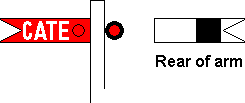 |
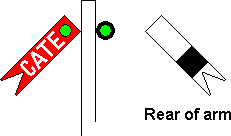 |
|
[16.5] Gate Distant Signal ('on').
Area: GER Usage: Medium Status: Historical |
[16.6] Gate Distant Signal ('off').
Area: GER Usage: Medium Status: Historical |
|---|
The Dornoch Light Railway opened in June 1902. Three level crossings on the line were each protected by a semaphore signal, which applied to trains in both directions. Each signal had just one arm, with a distinctive pointed end, both sides of which were coloured red with a white chevron [16.7 & 16.8]. The white chevrons were later replaced by white stripes [16.9 & 16.10].
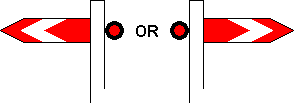 |
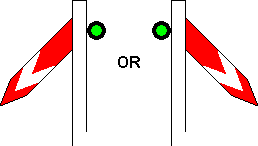 |
|
[16.7] Level Crossing Signal ('on').
Area: Dornoch Light Railway Usage: Low Status: Historical |
[16.8] Level Crossing Signal ('off').
Area: Dornoch Light Railway Usage: Low Status: Historical |
|---|---|
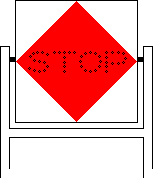 |
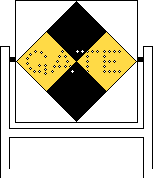 |
|
[16.9] Level Crossing Signal ('on').
Area: Dornoch Light Railway Usage: Low Status: Historical |
[16.10] Level Crossing Signal ('off').
Area: Dornoch Light Railway Usage: Low Status: Historical |
Another type of gated level crossing, only found on lightly used railways, is the "Trainman Operated Crossing" (TMO). The gates are normally closed across the railway and have to be opened and closed by the traincrew, as the name implies. Each rail approach to the crossing was marked by an ordinary distant signal fixed at 'caution' or alternatively a notice board (see Section 26) stating the distance to the crossing and its name, e.g. "Wensley Level Crossing 400 yards".
In February 1936, the LNER introduced a simplified signalling system on the line between Knaresborough Goods and Pilmoor North. An assortment of new boards was installed in 1935, not just for signalling purposes (see [25.13 - 25.17]) but also for level crossings. 'Gate stop boards' were provided at the line's four level crossings, these being fixed to the crossing gates at those crossings where the gates were swung across the railway. Red reflectors on the face of the board spelled out the word "stop" [16.11]. A 'gate caution board' was provided at a distance of about 600 yards (549 metres) on each rail approach to a level crossing. White reflectors on the face of the board spelled out the word "gate" [16.12]. In the 'off' position, neither the gate caution board nor the gate stop board were visible to drivers. During trials, the red reflectors on the gate stop boards were found to be not very effective, and white reflectors were substituted [16.13], the letters being arranged vertically to provide better differentiation from the gate caution boards. After passenger services on the line ceased in September 1950, the gate stop boards were removed, and the gate caution boards were fixed in the 'on' position. Each gate caution board was subsequently fitted with a yellow marker light [16.14]. The line closed to all traffic in October 1964.
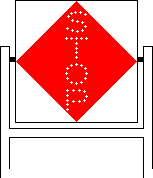 |
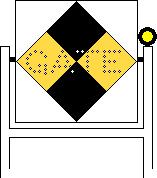 |
|
[16.11] Gate Stop Board ('on').
Area: Knaresborough - Pilmoor Usage: Low Status: Historical |
[16.12] Gate Caution Board ('on').
Area: Knaresborough - Pilmoor Usage: Low Status: Historical |
|---|---|
 |
 |
|
[16.13] Gate Stop Board ('on').
Area: Knaresborough - Pilmoor Usage: Low Status: Historical |
[16.14] Gate Caution Board.
Area: Knaresborough - Pilmoor Usage: Low Status: Historical |
Following new legislation in 1954, gates gradually began to give way to lifting barriers. In some places, neither gates nor barriers were installed. The first sign encountered by a train driver approaching an 'open' level crossing was a notice board stating the distance to the crossing, e.g. "ungated level crossing 250 yards ahead". At crossings where trains were not required to stop, this was followed by a whistle board (see Section 15). A speed restriction applied between the whistle board and the level crossing. The crossing speed depended on sighting conditions, and there could be a different speed in either direction. A 'cut-out' speed restriction sign was usually provided in conjunction with the whistle board.
Some open crossings simply had "give way" signs to warn road traffic, while others were given the extra protection of flashing road lights. The first open crossing with road lights was commissioned at Yafforth (North Eastern Region), in September 1963. A white light, which was normally extinguished, was provided on each rail approach to indicate a failure condition to train drivers. If the white light was flashing [16.15], it indicated that the power supply had failed but the road lights were operating. A steady white light was displayed [16.16] in the event of the road lights having failed, in which case train drivers were required to stop short of the crossing and not proceed over it until satisfied it was safe to do so. If a flashing or steady white light was displayed, the driver was required to report the circumstances at the next signal box.
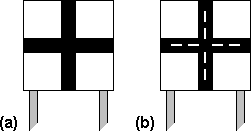 |
 |
|
[16.15] Driver's White Light (flashing).
Area: All Areas Usage: High Status: Current |
[16.16] Driver's White Light (steady).
Area: All Areas Usage: Low Status: Historical |
|---|
At a meeting of the Operating Committee in September 1966, it was noted that it was misleading for the driver's white lights to display no light while the crossing was operating correctly, since a complete failure of the lights would give the same indication. In December of the same year, the committee recommended that the operation of the driver's white lights be altered to display a steady white light (see [16.16]) to indicate to train drivers that the power supply is intact and the road lights are operating correctly. In May 1967, the committee recommended that the steady white light be replaced by a flashing white light (see [16.15]), and this change was adopted. The driver must check that the white light is flashing on passing the speed restriction sign and whistle board. The train may then proceed over the crossing providing it is not obstructed. If the light is out, a failure condition exists, and drivers are required to stop short of the crossing and not proceed over it until satisfied that it is safe to do so. Since 1981, this type of crossing has been known as "Automatic Open Crossing, Locally Monitored" (AOCL).
|
|